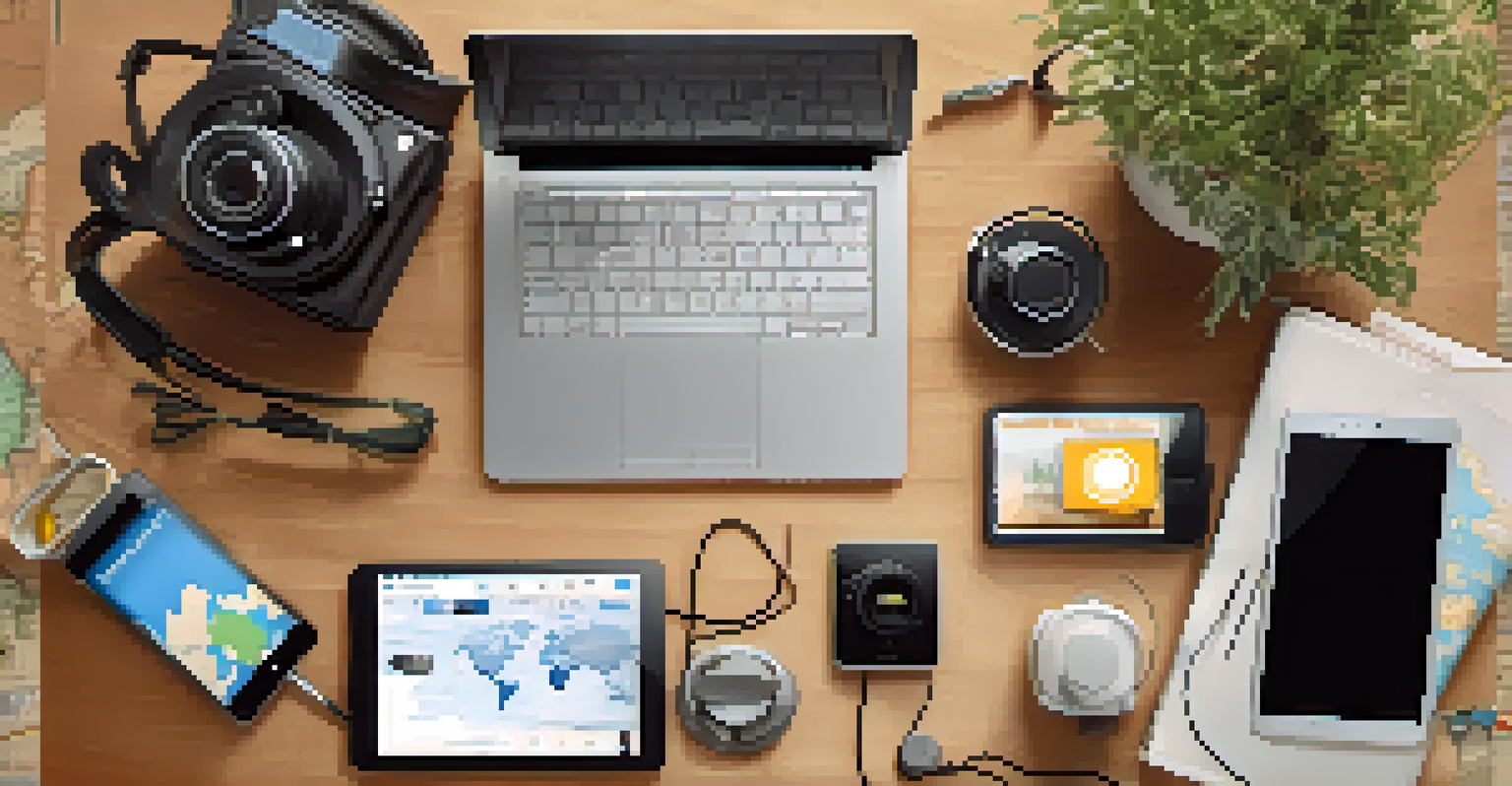Using Mobile Hotspots for Seamless Travel Connectivity

Understanding Mobile Hotspots and Their Benefits
A mobile hotspot is a portable device that provides internet access by connecting to cellular networks. This means you can access the internet on multiple devices, such as smartphones, tablets, and laptops, wherever you go. Think of it as your personal Wi-Fi that fits in your pocket, making it a must-have for travelers.
The world is a book, and those who do not travel read only one page.
One of the biggest benefits of using a mobile hotspot is the convenience it offers. Instead of searching for free Wi-Fi in cafes or hotels, you can stay connected on your terms. This is especially important for those who rely on navigation apps or need to check emails while on the go.
Additionally, mobile hotspots can often provide a more secure connection compared to public Wi-Fi networks, which can be vulnerable to cyber threats. By using a personal hotspot, you can protect sensitive data while enjoying seamless travel connectivity.
Choosing the Right Mobile Hotspot Device
When selecting a mobile hotspot device, consider factors like coverage, speed, and battery life. Different providers offer various plans, so it's essential to choose one that suits your travel needs. For instance, if you're traveling internationally, look for a device that supports global coverage.

Another important aspect is the number of devices that can connect simultaneously. If you're traveling with family or friends, ensure the hotspot can accommodate multiple connections without sacrificing speed. This way, everyone can stay connected without interruptions.
Benefits of Mobile Hotspots
Mobile hotspots provide convenient and secure internet access on the go, eliminating the need for public Wi-Fi.
Lastly, look for user-friendly features like data usage tracking and easy setup. A device that allows you to monitor your data consumption can help avoid unexpected charges, making your travel experience smoother and more enjoyable.
Setting Up Your Mobile Hotspot for Travel
Setting up your mobile hotspot is typically a straightforward process. Begin by inserting a SIM card (if required) and charging the device. Most hotspots come with a user manual, guiding you through the initial setup, which usually involves turning on the device and connecting to the network.
Traveling – it leaves you speechless, then turns you into a storyteller.
Once set up, connecting your devices is just a matter of searching for the hotspot's Wi-Fi name and entering the password. This ease of connection means you won't waste time fumbling with settings, allowing you to jump straight into your travel plans.
Don’t forget to test the connection before you leave your home or hotel. This way, you can troubleshoot any issues and ensure everything is working smoothly before embarking on your adventure.
Tips for Managing Data Usage While Traveling
Managing data usage is crucial, especially if you’re on a limited plan. Start by monitoring your data consumption regularly using the features provided by your hotspot. Many devices come with apps that help you track usage and set alerts when you’re nearing your limit.
Another effective strategy is to prioritize your online activities. Try to download maps, travel itineraries, or entertainment while connected to Wi-Fi instead of relying on mobile data. This approach conserves your data for essential tasks like navigation or communication.
Choosing the Right Device
Selecting a mobile hotspot involves considering factors like coverage, speed, and the number of simultaneous connections.
Lastly, consider using offline modes for apps whenever possible. Many services, such as Google Maps, allow you to download areas for offline use, saving you from using up data while exploring new places.
Connecting Multiple Devices on the Go
One of the standout features of mobile hotspots is the ability to connect multiple devices. This is particularly beneficial when traveling with a group, as everyone can access the internet without needing separate connections. Simply share the hotspot's password with your travel companions for seamless connectivity.
However, keep in mind that connecting too many devices can lead to slower speeds. To optimize performance, encourage everyone to connect only when necessary, and try to limit heavy data activities like streaming.
In situations where you have several devices connected, consider assigning priority to critical tasks. For instance, you might want to ensure that your navigation app has the bandwidth it needs while limiting other devices' usage.
Maintaining Battery Life During Your Trip
Battery life is a key consideration for mobile hotspots, especially during long travel days. Start by fully charging your device before heading out, and consider carrying a portable charger to keep it powered during your adventures. This way, you won’t be left without connectivity when you need it most.
To extend battery life, turn off the hotspot when not in use. Many devices have an auto-off feature that can help conserve power, but manually turning it off during downtime is a good habit to develop.
Managing Data and Battery Life
Monitoring data usage and maintaining battery life are essential for maximizing the efficiency of your mobile hotspot during travel.
Additionally, limit the number of devices connected at one time. Each connected device consumes battery, so the fewer devices you have online, the longer your hotspot will last throughout the day.
Troubleshooting Common Mobile Hotspot Issues
Even with the best devices, you might encounter some common issues while using mobile hotspots. One frequent problem is connectivity drops. If this happens, try moving to a different location, as physical obstructions can interfere with the signal.
Another common issue could be slow speeds. If your connection feels sluggish, check how many devices are connected and consider disconnecting those that aren’t in use. This can help free up bandwidth for essential tasks.

Lastly, consult your device’s manual or online resources for troubleshooting tips. Many manufacturers provide helpful guides for resolving common issues, ensuring you can stay connected and enjoy your travels without unnecessary stress.